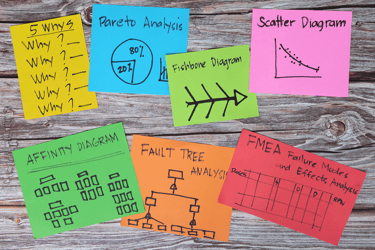The Packaging Industry's Sustainability Challenge: Why ERP Systems Are Essential for Success A straightforward guide to navigating sustainability regulations across folding carton, flexible...
Data-Driven Leadership in the Packaging Industry
The amount of data currently being generated is staggering. It is reported that 90% of the world’s data was created in the last two years.
Companies in the packaging and printing industries face a sizeable challenge: how to turn the data they generate into actionable insights to drive growth and innovation. In this context, data-driven leadership emerges as a fundamental approach to making smart, accurate, and fast decisions.
Peter Drucker coined the expression ‘if it can't be measured, it can't be improved’, which is even more relevant in the era of Industry 4.0. Access to real-time data is crucial to driving efficiency, quality, and innovation in operations.
That's why data-driven leadership is essential to ensure correct decisions based on accurate and reliable insights.
Contents
- What is Data-Driven Leadership?
- What are the Benefits of Data-Driven Leadership?
- The 4 Top Challenges for Packaging and Printing Companies Concerning Data-Driven Leadership
- How Being Data-Driven Offers Packaging and Printing Companies Competitive Advantage
- What is the Difference Between Data-Driven Enterprise and Data-Driven Leadership?
- Top Data-Driven Leadership Trends
- How to Promote Data-Driven Leadership?
- Turning Data into Valuable Insights
- What Kind of Data do Data-Driven Organizations Leverage?
- Conclusion
What is Data-Driven Leadership?
Data-driven leadership relies on the analysis and interpretation of data to guide the decision-making process. Rather than relying solely on intuition or experience, data-driven leaders use quantitative evidence to inform their decisions. In Industry 4.0, where digitalization and automation radically transform production processes in the packaging and printing industry, the ability to make data-driven decisions is more critical than ever.
What are the Benefits of Data-Driven Leadership
- Smarter, More Accurate Decisions: Identifying trends, predicting outcomes, and anticipating potential problems based on historical patterns and predictive analytics.
- Rapid and Agile Decision-Making: Access to real-time data and the use of advanced analysis tools allow you to quickly assess different scenarios and act with agility to seize opportunities.
- Optimization of Operational Efficiency: Minimization of risks and effective use of market opportunities.
The 4 Top Challenges Packaging and Printing Companies Face when Implementing Data-Driven Leadership
- Data Quality: Ensuring that the data collected is accurate, complete, and relevant is essential to avoid decisions based on incorrect information.
- Systems Integration: The integration of different systems and data sources can be complex, requiring investments in technology and infrastructure.
- Data Culture: Promoting an organizational culture that values and uses data for decision-making is a significant challenge, especially in companies with traditional practices.
- Analytical Skills: The lack of skilled data analytics professionals can make it difficult to correctly interpret data and generate actionable insights.
How Being Data-Driven Offers Packaging and Printing Companies Competitive Advantage
Packaging and printing companies that take a data-driven approach can differentiate themselves in several ways:
- Innovation: The ability to analyze data in real-time allows them to identify new market opportunities and develop innovative products.
- Efficiency: Using data to optimize operational processes results in increased efficiency and cost reduction.
- Customer Satisfaction: A better understanding of customer needs and preferences through data allows you to offer products and services that are more aligned with consumer expectations.
- Competitiveness: Data-driven companies can respond quickly to market changes while remaining competitive in a dynamic environment.
What is the Difference Between Data-Driven Enterprise and Data-Driven Leadership?
A data-driven company utilizes data at all levels and processes of the organization, from production to customer service.
Data-driven leadership, on the other hand, focuses specifically on business leaders' decision-making processes, ensuring that strategic and operational decisions are based on accurate and relevant data.
While a data-driven company may have advanced technologies and integrated systems, data-driven leadership requires an organizational mindset and culture that values and utilizes that data to make informed decisions.
Top Data-Driven Leadership Trends
Some emerging trends in data-driven leadership include:
- Artificial Intelligence (AI): Utilizing AI to analyze large volumes of data and provide predictive insights.
- Process Automation: Implementing automation to collect and process data more efficiently.
- Data Lakes: Creation of centralized data repositories to facilitate analysis and access to information.
- Data Visualization: Developing advanced visualization tools to make data more understandable and actionable.
How to Promote Data-Driven Leadership?
To foster data-driven leadership, companies should:
- Invest in Technology: Acquire and implement data analysis tools and industry-specific manufacturing execution systems.
- Develop Skills Internally: Train leaders and employees in data analysis and interpretation of insights.
- Promote a Data Culture: Encourage the use of data at all levels of the organization and value evidence-based decision-making.
- Monitor and Evaluate: Establish clear KPIs and continuously monitor performance to adjust strategies as needed.
Turning Data into Valuable Insights
Your data can help you to become more efficient, more profitable, and how to generate more sales. Using a platform like Metrics BI, you can easily turn your operation into a data-driven company with real-time visualization of your most important KPIs, and in turn, manage your business more effectively to increase your competitive advantage .
What Kind of Data do Data-Driven Organizations Leverage?
- Customer Analysis: Which customer is the most profitable? What products do they buy? Which is the least profitable and why? Analyze profit margins, customer behavior, and preferences, and identify optimization strategies and opportunities to increase sales.
- Revenue and Sales Metrics: Sales performance, revenue growth, sales by region or product, customer acquisition, and average transaction value. Identify trends, opportunities, and areas for improvement.
- Financial Analysis: Budgeting, forecasting, expense analysis, cash flow management, and financial ratios. It helps to identify areas of strengths and weaknesses, track performance against financial goals, and support financial decision-making.
- Discover Production Issues: Identify bottlenecks and opportunities to optimize operations, with operational efficiency metrics such as production cycle time, resource utilization, inventory levels, supply chain efficiency, and overall equipment effectiveness.
- Purchasing and Inventory Analysis: Create supplier scorecards and identify trends related to on-time deliveries, volumes, costs, ordered/pending/received amounts, and more.
Improve your productivity by reducing the time spent chasing down information, reconciling numbers, and building spreadsheets; allowing more time for tasks that add greater value to your organization.
Within a data-driven organization, meetings become more strategic, and your company becomes much more effective.
Conclusion
Data-driven leadership is crucial for packaging and printing companies that want to stay competitive in an increasingly dynamic market. Making decisions based on accurate data allows for greater agility, innovation, and operational efficiency.
Directors and decision-makers need to act quickly to adopt a data culture, invest in technology, and empower their teams. Not taking advantage of this opportunity means falling behind the competition.
Now is the time to turn data into actionable insights to optimize processes and improve profitability, get in touch we're eager to learn how we can help.



